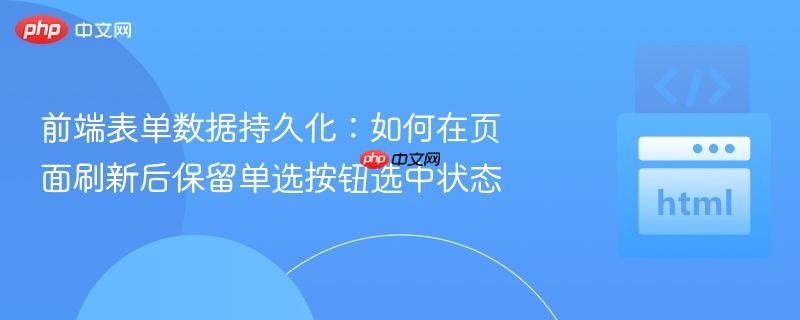
在现代Web应用中,用户经常需要填写复杂的表单。然而,一个常见且影响用户体验的问题是,当用户不小心刷新页面或在未提交表单前导航离开再返回时,已填写的数据会丢失。对于包含大量单选按钮(如考勤系统中的用户状态选择)的表单,这种数据丢失尤其令人沮丧。为了解决这一问题,我们可以利用客户端存储技术在浏览器端保存用户的选择,确保即使页面刷新,数据也能得以保留。
实现表单数据持久化的基本流程可以概括为三个步骤:
接下来,我们将详细介绍三种常用的客户端存储方法及其实现。
LocalStorage提供了一种在浏览器中存储键值对的方式,其数据没有过期时间,即使浏览器关闭后也会保留。这使得它非常适合存储用户偏好设置、未提交的草稿或需要长期保留的表单数据。
立即学习“前端免费学习笔记(深入)”;
假设我们有一个Django模板生成的单选按钮组,用于选择每个用户的状态:
<form action="{% url 'create_attendance' baksgewijs.id peloton.id %}" method="post">
{% csrf_token %}
<div class="table-responsive fixed-length">
<table id="userTable">
<tbody>
{% for user in users %}
<tr>
<td> {{ user.username }} </td> {# 假设 user 对象有 username 属性 #}
<td>
<div class="form-check">
<input class="form-check-input" type="radio" name="user_{{ user.id }}" id="radio_aanwezig_{{ user.id }}" value="Aanwezig">
<label class="form-check-label" for="radio_aanwezig_{{ user.id }}">Aanwezig</label>
</div>
<div class="form-check">
<input class="form-check-input" type="radio" name="user_{{ user.id }}" id="radio_afwezig_{{ user.id }}" value="Afwezig">
<label class="form-check-label" for="radio_afwezig_{{ user.id }}">Afwezig</label>
</div>
<div class="form-check">
<input class="form-check-input" type="radio" name="user_{{ user.id }}" id="radio_geoorloofd_{{ user.id }}" value="Geoorloofd afwezig">
<label class="form-check-label" for="radio_geoorloofd_{{ user.id }}">Geoorloofd afwezig</label>
</div>
</td>
</tr>
{% endfor %}
</tbody>
</table>
</div>
<input type="submit" value="Sla baksgewijs op" class="btn btn-primary active">
</form>
<script>
document.addEventListener('DOMContentLoaded', function() {
const radioGroups = document.querySelectorAll('input[type="radio"]');
// 恢复单选按钮状态
radioGroups.forEach(radio => {
const groupName = radio.name;
const storedValue = localStorage.getItem(groupName);
if (storedValue && radio.value === storedValue) {
radio.checked = true;
}
});
// 监听单选按钮变化并保存状态
radioGroups.forEach(radio => {
radio.addEventListener('change', function() {
if (this.checked) {
localStorage.setItem(this.name, this.value);
}
});
});
});
</script>代码解析:
SessionStorage与LocalStorage的API几乎相同,但其数据生命周期仅限于当前浏览器会话(即当前标签页)。当用户关闭该标签页时,SessionStorage中的数据会被清除。
将上述LocalStorage的示例代码中的localStorage替换为sessionStorage即可:
document.addEventListener('DOMContentLoaded', function() {
const radioGroups = document.querySelectorAll('input[type="radio"]');
// 恢复单选按钮状态
radioGroups.forEach(radio => {
const groupName = radio.name;
const storedValue = sessionStorage.getItem(groupName); // 使用 sessionStorage
if (storedValue && radio.value === storedValue) {
radio.checked = true;
}
});
// 监听单选按钮变化并保存状态
radioGroups.forEach(radio => {
radio.addEventListener('change', function() {
if (this.checked) {
sessionStorage.setItem(this.name, this.value); // 使用 sessionStorage
}
});
});
});Cookies是另一种客户端存储机制,它允许服务器和浏览器之间交换小段数据。与LocalStorage和SessionStorage不同,Cookies可以设置过期时间,并且每次HTTP请求都会自动携带到服务器。
使用JavaScript操作Cookies比LocalStorage和SessionStorage略复杂,因为它没有直接的setItem/getItem方法,需要手动解析document.cookie字符串。
// 辅助函数:设置Cookie
function setCookie(name, value, days) {
let expires = "";
if (days) {
const date = new Date();
date.setTime(date.getTime() + (days * 24 * 60 * 60 * 1000));
expires = "; expires=" + date.toUTCString();
}
document.cookie = name + "=" + (value || "") + expires + "; path=/";
}
// 辅助函数:获取Cookie
function getCookie(name) {
const nameEQ = name + "=";
const ca = document.cookie.split(';');
for (let i = 0; i < ca.length; i++) {
let c = ca[i];
while (c.charAt(0) === ' ') c = c.substring(1, c.length);
if (c.indexOf(nameEQ) === 0) return c.substring(nameEQ.length, c.length);
}
return null;
}
document.addEventListener('DOMContentLoaded', function() {
const radioGroups = document.querySelectorAll('input[type="radio"]');
// 恢复单选按钮状态
radioGroups.forEach(radio => {
const groupName = radio.name;
const storedValue = getCookie(groupName); // 使用 getCookie
if (storedValue && radio.value === storedValue) {
radio.checked = true;
}
});
// 监听单选按钮变化并保存状态
radioGroups.forEach(radio => {
radio.addEventListener('change', function() {
if (this.checked) {
setCookie(this.name, this.value, 7); // 设置Cookie,保存7天
}
});
});
});选择合适的存储方式:
HTML结构规范: 确保单选按钮组的name属性唯一,且每个单选按钮的id属性也唯一,这对于JavaScript操作和辅助功能(如label的for属性)至关重要。
通用处理函数: 对于多个表单或多个单选按钮组,可以编写一个更通用的函数来处理持久化逻辑,避免代码重复。
数据安全与隐私: 任何客户端存储都不应存放敏感的用户信息,因为这些数据可以被用户轻易访问和修改。
错误处理与兼容性: 在使用LocalStorage或SessionStorage时,建议检查浏览器是否支持(if (window.localStorage)),以提供更好的兼容性。在某些隐私模式下,这些API可能不可用。
通过合理利用LocalStorage、SessionStorage或Cookies等客户端存储技术,我们可以有效地解决页面刷新导致表单数据丢失的问题,极大地提升用户体验。开发者应根据数据的生命周期、存储容量需求以及是否需要服务器端访问等因素,选择最适合的持久化方案。遵循良好的HTML结构和JavaScript编程实践,将使表单数据持久化功能更加健壮和易于维护。
以上就是前端表单数据持久化:如何在页面刷新后保留单选按钮选中状态的详细内容,更多请关注php中文网其它相关文章!

每个人都需要一台速度更快、更稳定的 PC。随着时间的推移,垃圾文件、旧注册表数据和不必要的后台进程会占用资源并降低性能。幸运的是,许多工具可以让 Windows 保持平稳运行。




Copyright 2014-2025 https://www.php.cn/ All Rights Reserved | php.cn | 湘ICP备2023035733号